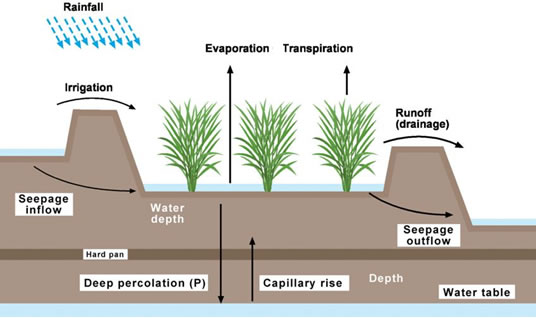Described in this article is the water flow of rice paddy field farms. Lowland irrigated water is the most accounted for production of rice being around 70-75% in the world overall rice production. Knowing the water flows (inflow and outflow) is important in keeping good water management and crucial for rice production. Observe the diagram at the end as well as videos displayed in this article to help in the understanding of water flow in relation to rice production.
Water Processes Involved With Rice Plants
All rice plants require plenty of water and are very sensitive to water loss, it’s important to keep watch over water levels whether they are over or under the ground. Moist soil can be adequate for rice plants as long as the roots can access it. They are 4 processes that get underway with rice plants, they are, Transpiration, Evaporation/Evapotranspiration, Seepage and Percolation.
Stomatal Transpiration
Movement of water through a plant is known as transpiration. In simple terms the movement starts out at the roots of the plant and is then carried up the plant and out through leaves as evaporation. However in more detail:
1) Roots of the rice plant start to soak up water in the surrounding soil through Osmosis.
2) Water then enters the Xylem, the Xylem is an area of the plant used to transport water and nutrients. It can be referred to as a pipeline system of the plant.
3) Water molecules are linked together through the process of cohesion. Water molecules contain a slight electric charge and get attracted to each other when they are close that creates them to group together.
4) Water is transported to the leaves and to the Stomata where the water then leaves as evaporation. Guard cells at the Stomata open and close the stomata as necessary. The Stomata is a pore found not only in leaves but also can be found in the stem and other organs of a plant.
See the following Clip on Transpiration:
Evaporation & Evapotranspiration
Everyday evaporation is created through natural heat from the sun and atmosphere. Many surfaces can contribute to this process such as soils and rivers where water is in supply. Rice plants are related by soil evaporation and evaporation through transpiration. Commonly this process can be related to vaporization as they both are similar processes. The difference between evaporation and vaporization consist of a few reasons, some of those reasons are:
|
Evaporation
|
Vaporization
|
| Happens at the surface of water | Can happen anywhere in the mass of the water |
| Vapors can be created below boiling point | Boiling point is used to conduct the process |
| Natural climatic changes such as wind can affect the rate | No climatic conditions will affect the rate |
| Slow process | Fast process |
Evapotranspiration, like the name suggest is a related to both transpiration and evaporation and where they both occur is why evapotranspiration can be associated. The reasoning behind this process is to calculate all water vapors that are added to the atmosphere, hence the sum of transpiration and evaporation is evapotranspiration…a sum of the two.
Percolation
The process of water sinking down through the soil is known as percolation. The best way to describe the process of Percolation is to think of the soil as a filter. When water sits upon the top of the soil it slowly gets filtered through the soil resulting in water loss for the crops. Percolation rates can differ through different soils due to the material content in the soil. Puddling is a good way to reduce the Percolation rate and help with water management – Water Management
Seepage
Another process where water is lost but can also be gained is through Seepage. Similar to Percolation seepage is the movement of water through the soil via pores in the soil. However the difference is mainly the direction where Seepage moves sideways or diagonally and Percolation moves downwards. For example, when water builds up but is blocked by the bunds the pressure of water starts to push the water into the bunds soil and results in water being pushed through the wall. Another example is where water levels rise so much that they overflow the bunds causing the water to seep over them resulting in water loss.
Seepage water tends to be the loss of water although in some instances seepage may occur from other sources into your field resulting in water gain.
Observe the following diagram about water flow. Image taken from IRRI – Use of Water


